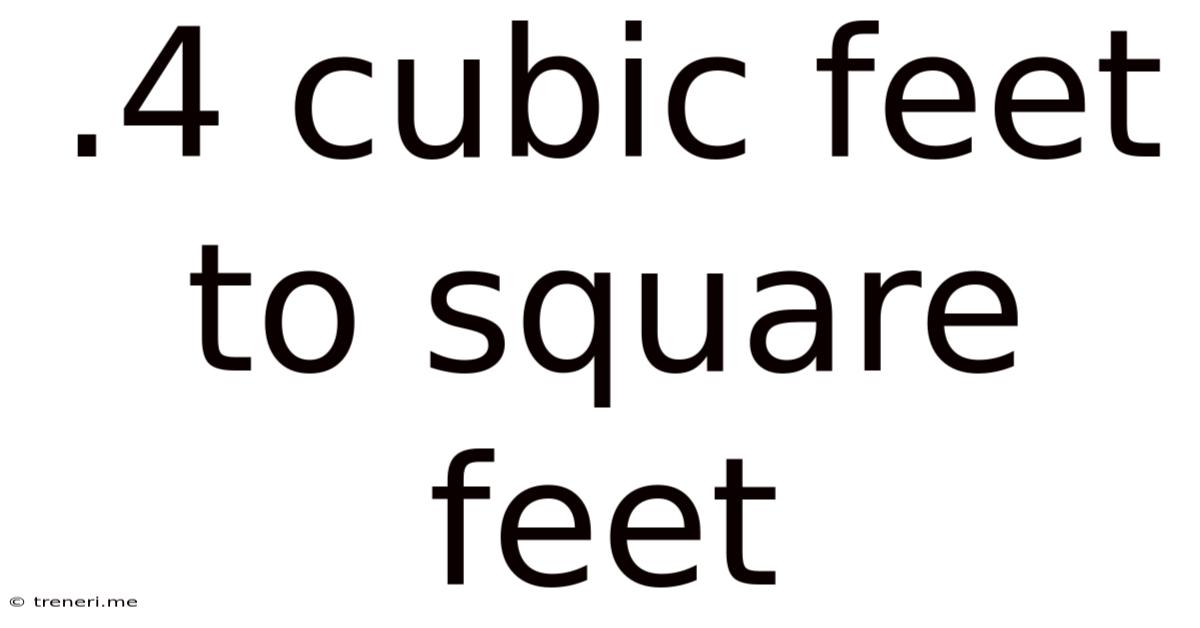.4 Cubic Feet To Square Feet
Treneri
May 15, 2025 · 4 min read

Table of Contents
.4 Cubic Feet to Square Feet: Understanding Volume and Area Conversions
Converting cubic feet to square feet isn't a direct conversion because they measure different things. Cubic feet (ft³) measure volume – the amount of three-dimensional space an object occupies. Square feet (ft²) measure area – the amount of two-dimensional space a surface covers. To understand the conversion, you need to know the depth or height of the object. This article will thoroughly explain the concept, providing examples and tackling common misconceptions.
Understanding the Difference: Volume vs. Area
Before diving into the conversion, let's clarify the fundamental difference between volume and area.
-
Volume: This measures the space occupied by an object in three dimensions – length, width, and height. Imagine a box; its volume is the total space inside the box. Cubic feet, cubic meters, and cubic yards are all units of volume.
-
Area: This measures the surface of a two-dimensional object – length and width. Think of the floor of a room; its area is the space it covers. Square feet, square meters, and square yards are all units of area.
You can't directly convert cubic feet to square feet without additional information because you're essentially trying to compare apples and oranges. It's like asking how many apples are in an orange – it doesn't make sense without context.
The Missing Variable: Depth or Height
To convert .4 cubic feet to square feet, we need to know the depth or height of the object or space in question. This is because volume is calculated using the formula:
Volume = Length x Width x Height
If we know the volume (.4 cubic feet) and either the height or depth, we can calculate the area (length x width) by rearranging the formula. Let's explore this with examples.
Example Scenarios and Calculations
Let's look at some scenarios illustrating how to perform this conversion with different givens.
Scenario 1: Knowing the Height
Let's say we have a container with a volume of 0.4 cubic feet and a height of 1 foot. To find the area of the base, we need to rearrange the volume formula:
Area = Volume / Height
Substituting our values:
Area = 0.4 ft³ / 1 ft = 0.4 ft²
Therefore, the area of the base of this container is 0.4 square feet.
Scenario 2: Knowing the Depth
Let's assume we have a layer of topsoil with a volume of 0.4 cubic feet and a depth of 0.2 feet. Again, we use the modified formula:
Area = Volume / Depth
Substituting the values:
Area = 0.4 ft³ / 0.2 ft = 2 ft²
In this case, the area of the topsoil layer is 2 square feet.
Scenario 3: Dealing with Irregular Shapes
The calculations above are simplified for objects with regular shapes (like cubes or rectangular prisms). For irregularly shaped objects, calculating the area becomes more complex. You might need to use more advanced techniques, potentially involving calculus and integration, depending on the shape's complexity. In many practical situations, approximation methods are used.
Practical Applications: Real-World Examples
Understanding this conversion is crucial in various applications:
-
Construction: Calculating the area of flooring, wall coverings, or tiling requires knowing the volume of material needed and its thickness.
-
Gardening: Determining the area of a garden bed given a specific volume of soil.
-
Aquariums: Calculating the base area of an aquarium given its volume and height.
-
Shipping and Packaging: Determining the base area of a package needed to accommodate a specific volume of goods.
-
Manufacturing: Calculating surface area of components in various industrial designs and projects.
Common Mistakes to Avoid
-
Direct Conversion: The most common mistake is trying to directly convert cubic feet to square feet without considering the height or depth. Remember, you can't do this.
-
Unit Confusion: Make sure you are consistent with your units throughout the calculations. Using a mix of inches, feet, and yards will lead to incorrect results.
-
Incorrect Formula: Ensure you use the correct formula to calculate volume and area and correctly rearrange the formula as needed.
-
Neglecting Irregular Shapes: For irregular shapes, don't assume a simple conversion is possible. Consider approximations or more sophisticated methods.
Advanced Concepts: Beyond Simple Shapes
For more complex shapes, the volume-to-area conversion becomes significantly more intricate. The concepts of integral calculus and surface integrals come into play. These methods are beyond the scope of this introductory article but demonstrate the mathematical depth of the conversion for non-uniform objects.
Conclusion: Mastering Cubic Feet to Square Feet Conversion
Converting .4 cubic feet to square feet isn't a simple arithmetic operation. It requires understanding the fundamental differences between volume and area and the role of the third dimension (height or depth). By following the steps outlined and avoiding the common pitfalls, you can successfully perform this conversion and apply it to various practical situations. Remember to always consider the shape of the object and the necessary formulas for accurate calculations. Understanding this concept is a crucial step toward mastering various geometrical and practical problems. With practice, these conversions will become intuitive and easy to apply.
Latest Posts
Related Post
Thank you for visiting our website which covers about .4 Cubic Feet To Square Feet . We hope the information provided has been useful to you. Feel free to contact us if you have any questions or need further assistance. See you next time and don't miss to bookmark.